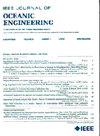水下电动机械臂遥操作约束优化与导向力反馈共享控制框架
IF 3.8
2区 工程技术
Q1 ENGINEERING, CIVIL
引用次数: 0
摘要
人在环遥操作是通过远程控制水下电动机械臂(UEM)来完成水下任务的常用策略。然而,UEM中流体动力学引起的非线性和各种不确定性、跟踪精度差、物理约束和通信延迟等问题,给UEM水下遥操作的实现带来了重大挑战。为此,本文提出了一种基于约束优化和导向力反馈的UEM远程操作共享控制框架,以提高水下操作效率,减少操作人员工作量。即在远端开发了一种自适应鲁棒控制器,以保证UEM在水下环境中的精确跟踪。由于操作者的指令无法提前获得,并且可能违反UEM的物理约束,因此设计了一个在线约束规划器,该规划器通过推力级配置转换策略考虑约束,以生成UEM跟踪的可行轨迹。在导引力反馈设计中考虑了约束条件,可以在违反约束条件时为操作者提供触觉反馈,防止操作者发出不安全的指令,保证水下遥操作的有效实施。最后,采用改进的波变量架构来完成远程操作控制,即使在机载操作员与UEM之间存在通信延迟的情况下,也能确保系统的稳定性。在真实的水下环境中进行了用户研究对比实验,以评估所提出的共享控制框架的有效性。本文章由计算机程序翻译,如有差异,请以英文原文为准。
A Shared Control Framework With Constrained Optimization and Guiding Force Feedback for Teleoperation of Underwater Electric Manipulator
Human-in-the-loop teleoperation is a commonly used strategy for accomplishing underwater tasks by remotely controlling an underwater electric manipulator (UEM). However, nonlinearities and various uncertainties caused by hydrodynamics in UEM, poor tracking accuracy, as well as physical constraints and communication delays, pose significant challenges to the implementation of underwater teleoperation with UEM. Therefore, this article proposes a shared control framework for UEM teleoperation, incorporating constrained optimization and guiding force feedback to enhance underwater operation efficiency and reduce the operator's workload. Namely, an adaptive robust controller is developed on the remote side to ensure accurate tracking of the UEM in the underwater environment. Since the operator's commands are not available in advance and may violate the physical constraints of the UEM, an online constraint planner, which considers the constraints via the jerk-level configuration transformation strategy, is designed to generate feasible trajectories to be tracked by the UEM. Furthermore, constraints are taken into account in the guiding force feedback design, which can provide the operator with haptic feedback when constraints are violated, thereby preventing the operator from issuing unsafe commands and ensuring the effective implementation of underwater teleoperation. Finally, the modified wave variable architecture is employed to complete the teleoperation control, ensuring system stability even in the presence of communication delays between the onboard operator and UEM. Comparative experiments with a user study are conducted in a real underwater environment to evaluate the effectiveness of the proposed shared control framework.
求助全文
通过发布文献求助,成功后即可免费获取论文全文。
去求助
来源期刊

IEEE Journal of Oceanic Engineering
工程技术-工程:大洋
CiteScore
9.60
自引率
12.20%
发文量
86
审稿时长
12 months
期刊介绍:
The IEEE Journal of Oceanic Engineering (ISSN 0364-9059) is the online-only quarterly publication of the IEEE Oceanic Engineering Society (IEEE OES). The scope of the Journal is the field of interest of the IEEE OES, which encompasses all aspects of science, engineering, and technology that address research, development, and operations pertaining to all bodies of water. This includes the creation of new capabilities and technologies from concept design through prototypes, testing, and operational systems to sense, explore, understand, develop, use, and responsibly manage natural resources.
 求助内容:
求助内容: 应助结果提醒方式:
应助结果提醒方式:


